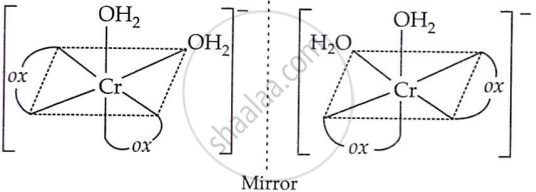Advertisements
Advertisements
Question
Indicate the types of isomerism exhibited by the following complex and draw the structures for these isomers:
K[Cr(H2O)2(C2O4)2]
Solution
Both geometrical (cis-, trans-) and optical isomers for cis are possible.
(a) Geometrical isomers (cis-trans):

(b) Optical isomers of cis (d- and l-):

APPEARS IN
RELATED QUESTIONS
Explain cationic complexes and anionic complexes of co-ordination compounds.
Draw one of the geometrical isomers of the complex [Pt (en)2Cl2] +2 which is optically inactive
Draw the geometrical isomers of complex \[\ce{[Co(en)2Cl2]+}\].
Draw the geometrical isomers of complex [Pt(NH3)2Cl2].
What type of isomerism is exhibited by the complex [Co(en)3]3+?
(en = ethane-1,2-diamine)
Indicate the types of isomerism exhibited by the following complex and draw the structures for these isomers:
[Co(en)3]Cl3
Write all the geometrical isomers of [Pt(NH3)(Br)(Cl)(py)] and how many of these will exhibit optical isomers?
Draw the geometrical isomers of complex \[\ce{[Pt(en)2Cl2]^2+}\].
Identify the optically active compounds from the following:
(i) \[\ce{[Co(en)3]^{3+}}\]
(ii) \[\ce{[trans - [Co(en)2Cl2]^+}\]
(iii) \[\ce{cis - [Co(en)2Cl2]^+}\]
(iv) \[\ce{[Cr(NH3)5Cl]}\]
Which one of the following complexes shows optical isomerism? (en = ethylenediamine)
Assertion (A): Trans [CrCl2(ox)2]3− shows optical isomerism.
Reason (R): Optical isomerism is common in octahedral complexes involving didentate ligands.
Indicate the types of isomerism exhibited by the following complexes and draw the structures for these isomers:
[Pt(NH3)(H2O)Cl2 ]
Indicate the types of isomerism exhibited by the following complexes and draw the structures for these isomers: [Pt(NH3)(H2O)Cl2]
Assertion: Addition of bromine water to 1-butene gives two optical isomers.
Reason: The product formed contains two asymmetric carbon atoms.
Indicate the type of isomerism exhibited by the following complex and draw the structure for this isomer:
[Pt(NH3)(H2O)Cl2]
Indicate the types of isomerism exhibited by the following complex and draw the structure for these isomer: \[\ce{[Pt(NH3)(H2O)Cl2]}\]
Indicate the types of isomerism exhibited by the following complexes and draw the structure for these isomer:
\[\ce{[Pt(NH3)(H2O)Cl2]}\]
Indicate the types of isomerism exhibited by the following complex and draw the structure for this isomer:
\[\ce{[Pt(NH3)(H2O)Cl2]}\]
Indicate the type of isomerism exhibited by the following complex and draw the structure for the isomer:
\[\ce{[Pt(NH3 )(H2O)Cl2]}\]
